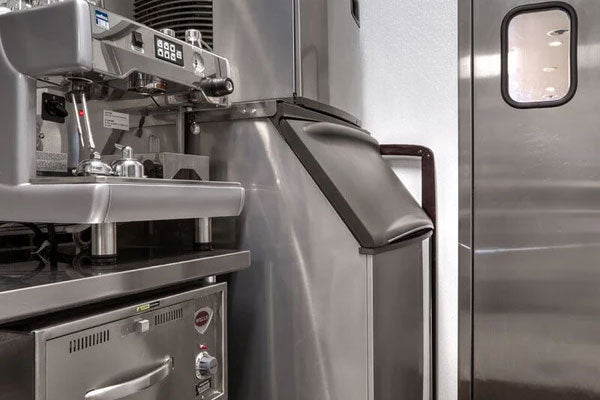Types of Commercial Ice Machines

In the foodservice industry, the little details matter. Take ice, for example. Whether you're serving soft drinks or fancy desserts, you need a steady supply of fresh ice to satisfy your customers. Almost every guest that visits your establishment will at least have an ice water (or another iced beverage), so poor quality ice will definitely make an impression. It's so important to invest in a commercial ice machine that can handle daily customer demand and produce the best ice for your needs.
Below, we've described the most common ice shapes and their applications. We've also broken down the difference between modular and undercounter ice machines, so you can select a machine that works well with your foodservice operation. Some machines will not be able to produce certain ice shapes, so you'll need to decide which shapes are more preferable for your business. By the end of this guide, you'll have a deep understanding of commercial ice, which will come in handy when crafting a cocktail (or making friends with Eskimos).
Ice Shapes
First, it's important to distinguish the different types of ice that a commercial ice machine can make. Some shapes are designed to melt slowly, while others have a pleasant texture. There are many ice shapes in the foodservice world, and these are the most popular options:
- Cube Ice: Most foodservice operations have ice machines that produce cube ice, which is great for soft drinks. Cubes melt slower than flakes or nuggets, because they have less surface area exposed, which can save your business money over time. Cube ice comes in three sizes: half cube, regular cube, and full cube.
- Half-cube Ice: Also known as "half-dice" ice, this is about half the size of full-cube ice, with the trademark rhombus cut-out in the cube shape. Half-cube ice is perfect for fast food restaurants, convenience stores, and most Ice machines that make half-cube ice are the biggest sellers on the market, because the ice type is so versatile. Half cubes will cool a drink more quickly than other cube types, because they have more surface area. However, half cubes are not the best choice for premium cocktails that you consume at a slower speed, because they will melt quickly and dilute the drink.
- Full Cube Ice: Also known as a "dice" cube, this is the largest cube size that a commercial ice machine can make. It's perfect for high-end drinks, liquor on the rocks, and situations where you need a slow-melting solution for keeping something cool. The large ice cubes look impressive in a glass, and they're a great centerpiece for a premium cocktail. However, full-cube ice is likely to be more expensive for bar owners because it displaces more liquid than smaller cubes.
- Flake Ice: Next, this ice type is primarily used for keeping food displays cool in a supermarket or buffet. Flake ice is soft and easy to mold like a snowball, so you can stuff it around meat and produce displays. It's also a good option when blending smoothies and other frozen drinks. We don't recommend flake ice for cooling down commonly consumed beverages, unless you're running a cafeteria for healthcare patients. Sometimes, the commercial ice machines that make flake ice are called "flaked" machines, or "flakers".
- Nugget Ice: Also known as "chewable" ice, the nugget ice type is a popular option in healthcare institutions, because it's softer than cube ice. Still, the nugget shape takes longer to melt than flake ice, so it finds a useful middle ground. Outside of the healthcare world, you'll find this ice in fast food establishments (like Sonic and Coffee Bean, which are known for nugget ice), local restaurants, and bars that serve frozen drinks. It's a great choice for margaritas, blended coffee drinks, and fruit smoothies.
Modular Ice Machines
Now that you have a solid understanding of the main ice types, it's time to decide which ice machine configuration will serve you best. At Chefs' Toys, we've broken down the machines into two main categories: modular and undercounter. Before choosing a machine, you should think about how the machine will be used on a regular basis. First, modular ice machines can be installed above any ice storage bin or dispenser. They can produce a minimum of 250 lbs. of ice per day, and the larger machines are capable of making 1000 lbs. per day. "Modular" refers to the machine's need for separate pieces, as well as its versatile design. When using this style of machine, you’ll need a separate storage unit to collect the ice.
Undercounter Ice Machines
On the other hand, if you're looking for a more compact solution, an undercounter ice machine might do the trick. Typically, the machine is installed behind a bar or restaurant counter, and it's designed with a built-in storage bin. However, it has a much lower output than a modular machine, with the largest models producing around 300 lbs. per day. This is a great option for local bars and cafes with lower ice consumption.
Matching the Machine to the Restaurant Type and Need
After narrowing down your selection to a modular or undercounter ice machine, you still need to make a few more decisions about which model works best for your business. All ice machines are designed with a condenser, which minimizes the unit's heat so that it can continue to produce ice. The machine you choose should have a condenser that works well in your establishment. Here are the three main condenser types:
- Air Cooled: This is the most popular condenser type, because it uses the least amount of water. It relies on built-in fans that blow air across the condenser, and you don't need to install extra wiring to use it. However, you should have enough space in your kitchen or bar to provide adequate clearance for the machine's airflow. For most consumers, an air-cooled condenser is the easiest option. We also recommend checking with your local utility company to see if you qualify for energy rebates.
- Water Cooled: This condenser type pumps water next to the condenser's heated coils to cool it down. Like the air cooled condenser, the entire system is built inside the ice machine, but you need a reliable source of cool water. This is a smart option for areas with high temperatures and poor air quality, but it uses a significant amount of water.
- Remote Cooled: Finally, this condenser is installed separately from the ice machine (usually mounted on the roof). A remote ice machine is ideal for facilities that need to eliminate the heat and noise produced by the ice maker, especially if you’re operating multiple systems in the same area. However, your ice machine will be extremely quiet if the condenser is installed outside.




















